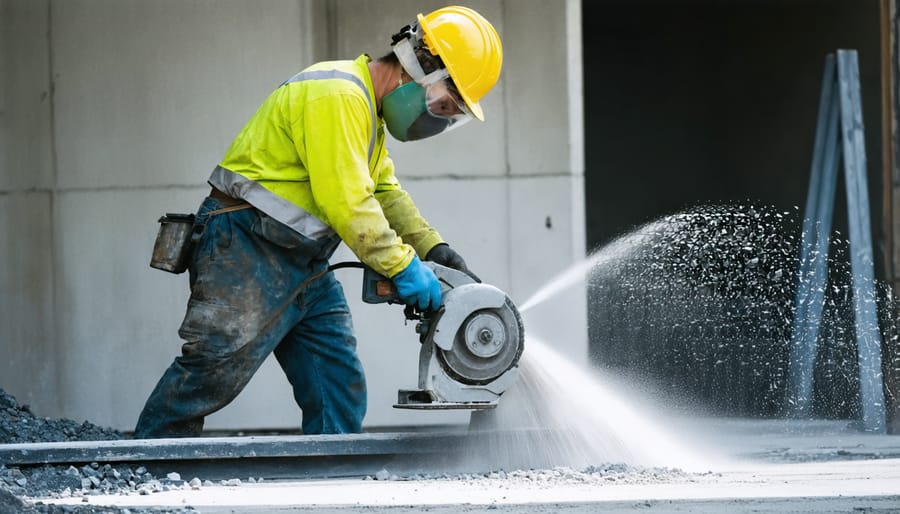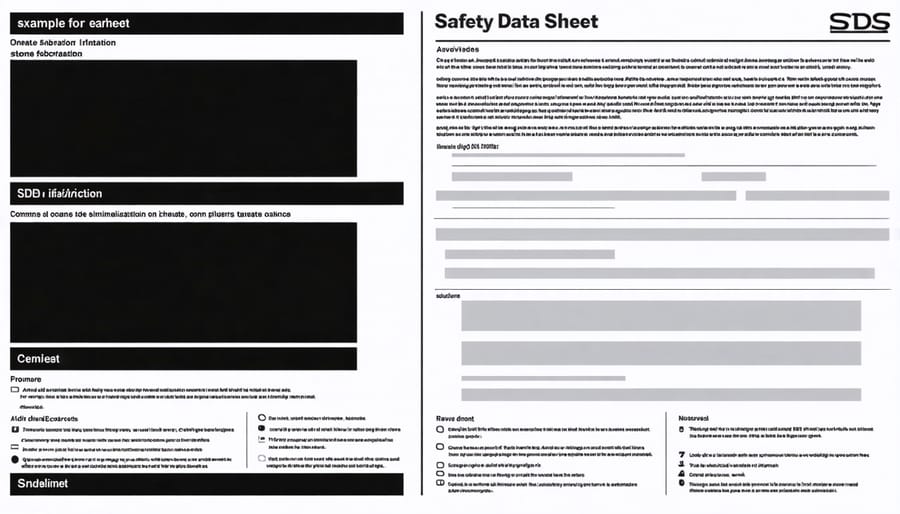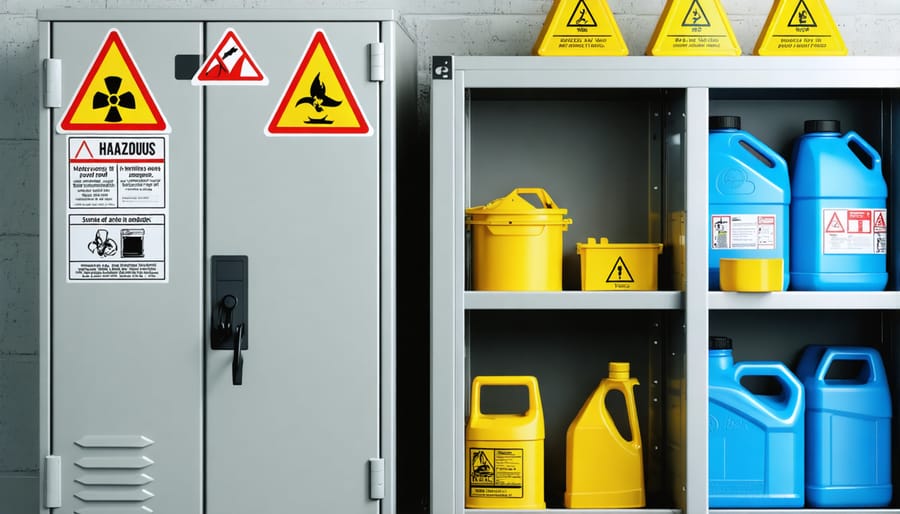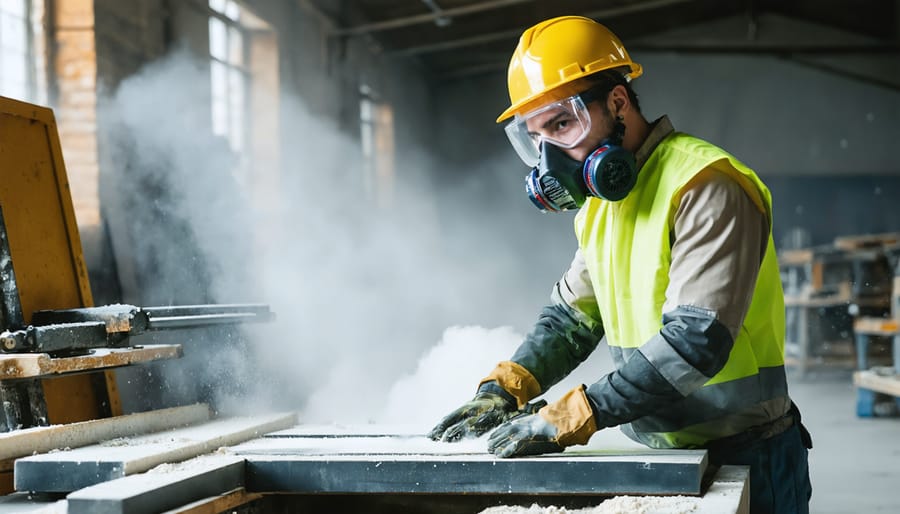A hazardous material fundamentally poses significant risks to human health, safety, property, or the environment during handling, storage, or transport. In stone fabrication, these materials range from crystalline silica dust to chemical sealants and adhesives that can cause immediate or long-term health effects. Understanding hazardous material classification is critical, as these substances exhibit at least one of four characteristics: ignitability, corrosivity, reactivity, or toxicity.
The Occupational Safety and Health Administration (OSHA) strictly regulates hazardous materials, requiring proper identification, labeling, and management protocols to protect workers and facilities. This comprehensive approach ensures safety through mandatory Safety Data Sheets (SDS), appropriate personal protective equipment (PPE), and established emergency response procedures. Industry professionals must recognize that even common materials in stone fabrication can become hazardous when improperly handled or when transformed during processing, making proper identification and management essential for workplace safety and regulatory compliance.
What Makes a Material Hazardous in Stone Fabrication?
Physical Hazards
Physical hazards encompass materials that can cause immediate harm through their physical properties rather than chemical composition. In stone fabrication, common physical hazards include compressed gases used in pneumatic tools, flammable liquids like sealants and adhesives, and pressurized containers storing cleaning agents.
Flammable materials present a significant risk, as they can easily ignite under normal working conditions. These include many solvents, finishing products, and certain types of adhesives used in stone installation. Compressed gases, whether in cylinders or systems, pose explosion risks if damaged or improperly handled.
Other physical hazards include materials that can cause harm through extreme temperatures, such as heated elements in stone processing equipment, or through stored energy, like pressurized systems. Additionally, materials that can create explosive atmospheres when dispersed in air, such as stone dust, require careful management and proper ventilation systems.
Safety protocols must address proper storage, handling, and disposal of these materials to prevent accidents and ensure workplace safety.
Health Hazards
In the stone fabrication industry, understanding stone processing health risks is crucial for workplace safety. Hazardous materials commonly encountered include respirable crystalline silica dust, which can cause serious respiratory conditions like silicosis when inhaled. Chemical compounds used in stone treatment and maintenance, such as acidic cleaners and sealants, pose risks through skin contact or inhalation of fumes. Wet grinding slurry contains fine particles that can be harmful if proper protective equipment isn’t used. Some engineered stones contain high concentrations of silica, making them particularly dangerous during cutting and fabrication processes. Even seemingly harmless materials like stone dust can become hazardous when accumulated in high concentrations or when proper ventilation is inadequate. Understanding these health hazards is essential for implementing effective safety protocols and protecting worker well-being.
Common Hazardous Materials in Stone Fabrication
Crystalline Silica
Crystalline silica, commonly found in natural stone and engineered quartz materials, poses significant crystalline silica exposure risks during fabrication and installation processes. This microscopic mineral becomes hazardous when stone is cut, ground, or polished, releasing respirable dust particles that can penetrate deep into the lungs. Workers in stone fabrication facilities are particularly vulnerable when proper safety measures aren’t implemented.
The hazardous nature of silica dust is determined by particle size and concentration levels. Particles smaller than 10 microns are especially dangerous, as they can bypass the body’s natural filtration systems. Long-term exposure can lead to silicosis, lung cancer, and other serious respiratory conditions. OSHA classifies crystalline silica as a hazardous material when airborne concentrations exceed permissible exposure limits of 50 micrograms per cubic meter of air, averaged over an 8-hour workday.
To protect workers, proper dust collection systems, wet cutting methods, and appropriate personal protective equipment are essential safeguards that must be implemented in any stone fabrication environment.

Chemical Products
In stone fabrication, various chemical products are classified as hazardous materials due to their potential risks to health and safety. Common sealants and adhesives used in stone bonding often contain volatile organic compounds (VOCs) and toxic substances that require careful handling. Epoxy-based adhesives, while effective for stone joining, may contain harmful components that can cause respiratory issues or skin irritation upon exposure.
Cleaning products used in fabrication processes frequently include acids, alkalis, and solvents that pose significant risks. Stone cleaners containing hydrofluoric acid or muriatic acid are particularly dangerous, capable of causing severe burns and respiratory damage if mishandled. Even seemingly harmless products like acetone-based cleaners can present fire hazards and health risks when used improperly.
Stone sealers, essential for protecting finished surfaces, often contain chemicals that require proper ventilation during application. Many contain silane or fluoropolymer compounds that can be harmful if inhaled or absorbed through skin contact. Understanding these products’ Material Safety Data Sheets (MSDS) is crucial for proper handling and emergency response procedures.
Always store these chemical products in appropriate containers, maintain proper ventilation, and use recommended personal protective equipment when handling them.
Other Hazardous Materials
Beyond common stone fabrication materials, numerous other substances in workshops require careful handling and proper safety protocols. Fuel storage tanks, whether for vehicles or equipment, contain flammable materials that pose significant fire hazards. Various lubricants and oils used in machinery maintenance can be both flammable and environmentally harmful if not properly contained. Cleaning solvents, particularly those used for equipment maintenance and surface preparation, often contain volatile organic compounds (VOCs) that require special storage and disposal procedures. Battery acid from equipment batteries and certain adhesives used in stone installation also fall under hazardous materials classification. Always store these materials in appropriate containers, maintain proper ventilation, and follow local regulations for disposal to ensure workplace safety and environmental compliance.
Identifying and Managing Hazardous Materials
Safety Data Sheets (SDS)
Safety Data Sheets (SDS) are critical documents that provide detailed information about the hazards and safe handling procedures for specific materials. These standardized documents contain 16 sections, including hazard identification, first-aid measures, handling and storage guidelines, and exposure controls. Every hazardous material used in stone fabrication must have an accompanying SDS readily available to workers.
To effectively use an SDS, first locate the chemical identification section to confirm you’re reviewing the correct document. Pay special attention to the hazard identification section, which outlines potential risks and safety precautions. The exposure controls section provides essential information about required personal protective equipment (PPE) and safe exposure limits.
Employers must maintain current SDS for all hazardous materials in their workplace and ensure they’re easily accessible to employees. Workers should review these documents before handling any new materials and reference them for proper emergency response procedures. Regular training on SDS interpretation helps maintain workplace safety and compliance with OSHA regulations.
Keep SDS organized in a clearly marked location, either in physical binders or digital format, and update them whenever new materials are introduced or existing documents are revised by manufacturers.

Storage and Handling
Proper storage and handling of hazardous materials is crucial for workplace safety and regulatory compliance. All hazardous materials must be stored in designated areas with appropriate ventilation, temperature control, and containment systems. Following safe storage practices includes maintaining clear labeling, using compatible storage containers, and keeping detailed inventory records.
Segregate incompatible materials to prevent dangerous reactions, and ensure storage areas have proper spill containment measures. Emergency response equipment, including fire extinguishers and spill kits, should be readily accessible. Regular inspections of storage areas help identify potential hazards like damaged containers or improper storage conditions.
When handling hazardous materials, workers must use appropriate personal protective equipment (PPE) and follow established procedures. This includes proper lifting techniques, using mechanical aids when necessary, and maintaining clear documentation of all material movements. Training programs should cover proper handling procedures, emergency protocols, and the use of safety equipment.
Implement a systematic approach to waste disposal, ensuring compliance with local regulations and maintaining detailed disposal records. Regular staff training and updated safety protocols are essential for maintaining a safe working environment.

Disposal Procedures
Proper disposal of hazardous materials requires strict adherence to local, state, and federal regulations. Materials must be segregated by type and stored in appropriate, clearly labeled containers. Never mix different hazardous materials, as this can create dangerous chemical reactions. Contact a certified waste management company for collection and disposal of hazardous materials.
Environmental considerations are paramount during disposal. Use designated disposal facilities that meet EPA requirements. Maintain detailed records of all disposals, including material types, quantities, and dates. Implement a spill prevention plan and keep appropriate containment equipment readily available.
For liquid hazardous materials, use approved secondary containment systems to prevent environmental contamination. Never dispose of hazardous materials in regular trash, down drains, or on the ground. Consider waste minimization strategies, such as recycling when possible, to reduce environmental impact and disposal costs.
Legal Requirements and Compliance
The management of hazardous materials is governed by numerous federal, state, and local regulations that establish strict guidelines for handling, storage, transportation, and disposal. The Occupational Safety and Health Administration (OSHA) requires employers to maintain comprehensive hazard communication programs, including detailed Safety Data Sheets (SDS) for all hazardous materials present in the workplace.
Companies must comply with the Resource Conservation and Recovery Act (RCRA), which sets standards for the proper management of hazardous waste from generation to disposal. The Environmental Protection Agency (EPA) enforces these regulations and requires proper documentation, including manifests for waste transportation and disposal.
Transportation of hazardous materials falls under the Department of Transportation (DOT) regulations, which mandate specific packaging, labeling, and documentation requirements. Employees handling hazardous materials must receive appropriate training as specified by OSHA’s Hazardous Waste Operations and Emergency Response (HAZWOPER) standard.
State and local authorities may impose additional requirements, such as permits for storage facilities or specific disposal procedures. Regular inspections, accurate record-keeping, and employee training documentation are essential for maintaining compliance. Non-compliance can result in significant fines, legal penalties, and potential criminal charges for serious violations.
Business owners must stay current with changing regulations and ensure their hazardous material management programs adapt accordingly to maintain compliance and workplace safety.
Understanding and properly managing hazardous materials is crucial for workplace safety and environmental protection. These substances, which pose risks through their physical, chemical, or biological properties, require careful handling, storage, and disposal procedures. By following proper identification protocols, maintaining accurate documentation, and implementing comprehensive safety measures, organizations can effectively minimize risks and protect their workers and the environment. Remember that hazardous material management is not just about compliance – it’s about creating a safer workplace and demonstrating commitment to responsible business practices. Stay informed about regulations, invest in proper training, and regularly review safety protocols to ensure your hazardous material management program remains effective and up-to-date.










